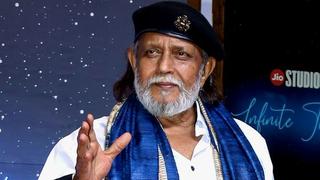Dadasaheb Phalke Award: reward for Mithun Chakraborty’s versatility

Mithun Chakraborty.
| Photo Credit: ANI
In an industry which foists a new deity every Friday, Mithun Chakraborty’s has been a story of resilience. Announced as the recipient of the Dadasaheb Phalke Award on Monday (September 30, 2024), Mithun Chakraborty has never been a prisoner of image. From arthouse to mainstream commercial cinema to even fare meant unabashedly for frontbenchers, he has straddled different genres with consummate ease.
Beginning with Mrinal Sen’s Mrigayaa in 1976, he has probably been the only major actor to make a successful transition from arthouse cinema to commercial potboilers and back. While Naseeruddin Shah, Shabana Azmi, Om Puri and Smita Patil each dabbled with limited success in mainstream cinema after carving out their own niche in parallel cinema, Mithun is the only one to get a good bite of the cherry.
In parallel cinema, he has worked with the likes of Mrinal Sen, Buddhadeb Dasgupta and Goutam Ghose, winning three National Awards in the process. He switched to mainstream fare with the likes of B. Subash, K.C. Bokadia, Manmohan Desai and Parto Ghosh without a hiccup, giving his fans films like Disco Dancer, Dance Dance, Pyar Jhukta Nahin, Ganga Jumna Saraswati, Agneepath and Dalaal, etc. Director B. Subash’s Disco Dancer got Mithun an international fan following with the film raking it rich in the Soviet Union, Japan and China besides India. For a few years in the mid-80s, he was the best-known Indian abroad. At a time when Hindi cinema was dominated by Salim-Javed’s ‘Angry Young Man’ persona, Mithun rewrote the box office rules with Disco Dancer, where Bappi Lahiri’s music and his dance numbers ensured repeat audiences.

For a brief while in the late 80s, he challenged Amitabh Bachchan for the top slot in Hindi cinema, encouraging Desai to give him a meaty role in Ganga Jamunaa Saraswati, a rarity in Hindi cinema where most heroes played second fiddle to Bachchan.
Yet, Mithun’s most durable claim to fame has to be his foray into serious cinema where his work in films like Tahader Katha, Kaalpurush, Swami Vivekanand and Gudiya is still remembered. With his restrained work in arthouse cinema, he disproved the notion that an action hero of Hindi cinema could not pull off neorealism fare. Tahader Katha, Kaalpurush, Swami Vivekanand and Mrigayaa, each one got a National Award giving Mithun his own niche in serious cinema, and making sure his popularity traversed from first-day-first-show to film festival circuit.
There is, however, another aspect of Mithun’s career which has been under-appreciated. He is probably the first A-grade star to work in films specially made for the less-discerning audiences. In the mid-90s, Mithun reworked the economics of cinema by shooting for films exclusively in Ooty with a standard cast comprising the likes of Hemant Birje, Gautami, Deepti Bhatnagar, Kiran Kumar and Raza Murad with music by Dilip Sen-Sameer Sen. The films, made on a shoe-string budget of around ₹40 lakh, were completed within a month or so and released without fanfare at smaller centres. Films like Jallad, Chandaal, Dada, Hitler, The Don and Cheetah were not heard of in metropolises but earned the producers sizeable profit besides keeping Mithun’s hardcore fans in small towns happy. Interestingly, while G.V. Iyer took 11 years to complete the research for Mithun’s Swami Vivekanand, the star meanwhile completed more than 20 films!
In recent times, Mithun has played supporting roles in films like TheKashmir Files and The Tashkent Files, forays which probably went some way in convincing the three-member jury comprising former Dadasaheb awardee Asha Parekh, actor-politician Khushbu Sundar and filmmaker Vipul Amrutlal Shah to select Mithun Chakraborty for the highest honour in Indian cinema.
Published – October 01, 2024 08:53 am IST

